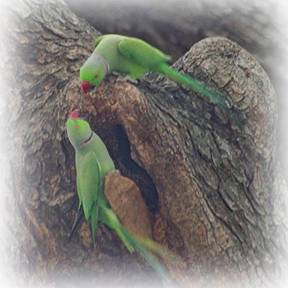By -
Ragoo Rao
Winter is quietly creeping in and the rains are fading out and the scenario is changing over to a different mood. Most of the Bird and Animal watchers may be preparing to study their interest in its winter settings. Down South here
it's a haven for animal study groups to visit our Sanctuaries. Most of the ungulates are with their young ones. Specially the young fawns of spotted deer and Gaur calves. Its a sight to see them gamboling around their herds with abandon. The forest cover is
also beautiful this time of the year as most of the deciduous trees are in bloom and flocks of Crimson headed parakeets swarm the Erythrina blooms.
This month I have chosen the Rose ringed parakeet for our Bird of the Month slot.
The most loved among the pet birds all over the world is undisputedly the Parrot. The Parrots come in a variety of sizes and colors depending upon their Geographical locations. From the small Budgerigars (Love birds) to the huge
Scarlet Macaws they all belong to one family-Psittacidae.
 The Rose ringed parrot is very familiar to both urban and rural areas. The green colored birds with red hooked beaks and a pointed tail is practically distributed all over the country. The males have a dark pink ring like marking
around their neck-hence the name. Often large flocks can be seen in the late evenings in leafy trees in the country side noisily settling down to roost. The same large flocks also roost amid bustling urban area avenue trees. These flocks raid maize crops of
farmers often wasting more than what they actually eat. Orchards are a favorite foraging area for these birds. They are gregarious feeders.
The Rose ringed parrot is very familiar to both urban and rural areas. The green colored birds with red hooked beaks and a pointed tail is practically distributed all over the country. The males have a dark pink ring like marking
around their neck-hence the name. Often large flocks can be seen in the late evenings in leafy trees in the country side noisily settling down to roost. The same large flocks also roost amid bustling urban area avenue trees. These flocks raid maize crops of
farmers often wasting more than what they actually eat. Orchards are a favorite foraging area for these birds. They are gregarious feeders.
These birds are not shy and they always make known their presence with their loud Keeeak....keeek...keeeeak calls. When a breeding pair is noticed quietly without disturbing them, one can hear varied vocalizations.They could be found
interacting vocally with each other which appear like mumbling. Parrots have a large vocabulary.
The main nesting season is between February and May varying locally depending upon the food availability and weather. A natural hollow is selected in tall trees and both the birds work out by carving out their requirement with their
powerful beaks. When one bird is busily carving inside the other stands at the entrance to warn any intrusion. With one loud k week.... from the guard bird both of them bolt off. Sometimes high barn walls are also selected for nesting.4 to 6 white eggs are
laid. Both sexes share all the domestic chores. In about 6 weeks the fledglings are ready to start their own life.